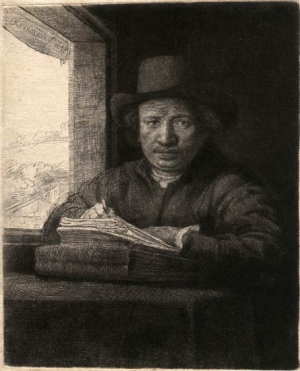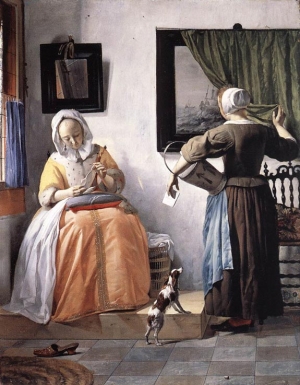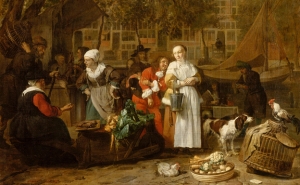|
Displaying items by tag: Dutch Master
France is bidding to buy one of two rare works by Dutch master Rembrandt van Rijn to prevent its current owner, the Rothschild family, from shipping the painting to Amsterdam.
Culture Minister Fleur Pellerin said the Bank of France would make an “exceptional” donation of 80 million euros ($89 million) to purchase one of the 17th century paintings for the Louvre Museum, just four days after the Netherlands said it had made an offer to buy both masterpieces.
The Netherlands and Amsterdam’s Rijksmuseum intend to buy two rare works by Dutch master Rembrandt van Rijn, repatriating the 1634 masterpieces after more than a century of ownership by France’s Rothschild family.
Each buyer plans to pay 80 million euros ($90 million), according to the Ministry of Culture. About 50 million euros of the Dutch state’s portion is going to come from dividends paid out from the state’s ownership of companies including ABN Amro Group NV.
The Art Gallery of Hamilton has agreed to return a painting recently proven to have been seized from its rightful owners by the Nazis during the Second World War, the gallery announced Tuesday.
"Portrait of a Lady," by 17th-century Dutch painter Johannes Verspronck, will be returned to the family of Alma Bertha Salomonsohn, whose husband Arthur was chairman of the board of Deutsche Bank.
Christie’s auction house says science has confirmed that a disputed painting is the work of Dutch master Johannes Vermeer. The painting could fetch 8 million pounds ($13 million) when it is sold next month.
“Saint Praxedis” is believed to be the earliest surviving work by the 17th-century artist, but there has long been a question mark over its authenticity.
The work was tentatively attributed to Vermeer after it appeared in an exhibition at New York’s Metropolitan Museum in 1969, and the authorship was reinforced in 1986, when leading Vermeer scholar Arthur Wheelock argued it was authentic.
The painting shows an old, weary man slumped in contemplation in his armchair and has spent more time in the National Gallery's storeroom than on display because it is attributed to a follower of Rembrandt rather than the artist himself.
But the gallery is being urged to rethink. The academic widely acknowledged as the world's leading expert on Rembrandt is about to drop an art historical bombshell by arguing it was not only painted by the 17th century Dutch master himself, but it is also a pivotal work for the artist.
"It is of wonderful quality and is revolutionary in a sense," Ernst van de Wetering told the Guardian. "It is a very important painting."

The Morgan Library & Museum announced today that it has completed the digitization of its entire collection of Rembrandt etchings: nearly 500 images of works by the Dutch master are now available online. According to the Morgan, “Rembrandt used the process of etching to test concepts and themes, and the digitized works offer the opportunity to explore up-close his use of line, shading, and subject matter.” The prints feature Biblical scenes, self-portraits, and depictions of the Dutch countryside and society in the artist’s day (including both beggars and art patrons).
The Morgan holds in its collection most of the roughly 300 known etchings by Rembrandt, including rare, multiple versions (hence the discrepancy in number of etchings versus number of images). Their digitization is part of a larger effort by the museum “to expand access to its holdings,” says the press release. This includes the digitization of over 500 music manuscripts begun in 2010 and the ongoing digitization of the institution’s collection of nearly 12,000 drawings.
A documentary about the Dutch painter Johannes Vermeer (1632-1675) has been acquired for distribution by Sony Pictures Classics. Tim’s Vermeer, which was directed by Teller of the illusionist duo Penn & Teller, features Tim Jenison, a Texas-based inventor who explores how Vermeer created his shockingly photo-realistic paintings a century before photography existed.
At one point during his ten-year investigation, Jenison traveled to Delft, Holland, where Vermeer worked, to meet with the British artist David Hockney, who had also questioned how Vermeer and his contemporaries created their breathtakingly realistic paintings. Using 17th century technology such as lenses and mirrors, Jenison eventually figured out the technique used by the Dutch master “supporting a theory as extraordinary as what he discovers,” Sony Pictures Classics said in a news release.
Sony Pictures Classics will release Tim’s Vermeer in 2014.

In the 18th century, the best-informed dealers and collectors would have counseled against buying a Vermeer if a Metsu was available. Today, while the name Johannes Vermeer guarantees record crowds at any exhibition, that of his contemporary Gabriel Metsu is familiar mainly to serious devotees of Dutch Golden Age painting. During the past year, however, Metsu may have reclaimed some of his former renown, thanks to a tightly focused and informative touring exhibition jointly organized by the National Gallery of Ireland, Dublin; the Rijksmuseum, Amsterdam; and the National Gallery of Art, Washington, where we can now discover this once-acclaimed master for ourselves.
According to Arthur K. Wheelock Jr., the National Gallery's curator of northern baroque painting and the show's coordinator, the exhibition attempts to deal with "the problem of Metsu"—that is, to make sense of the many diverse types of pictures he produced during his relatively brief career. (Born in 1629, he died in 1667.) In Washington, the modest number of Metsus on view includes religious subjects, moralizing genre scenes, risqué dramas, portraits, self-portraits, a city view, arcane symbolic compositions, glorifications of youthful charms, studies of old age, and more. This range is surprising in an era when Dutch artists tended to be pragmatic specialists, known as portrait or history painters (including religious and mythological subjects) or as authors of scenes of everyday life, marine views or cityscapes. Prof. Wheelock speculates that Metsu's atypical, restless investigation of different approaches may indicate a canny sense of what would today be called "niche marketing"—testing the Dutch art-buying public's appetites as he aimed at establishing himself as someone to be reckoned with, first in his native Leiden and then in Amsterdam; he might have, for example, explored how Amsterdammers responded to picturesque Leiden-style images of elderly women and then tried something else if interest waned.
This multiplicity also applies to manner. Metsu could convincingly evoke many of the other leading painters of the period. He certainly prided himself in his virtuoso ability to render textures with paint, filling his works with shimmering silks, thick woolens, soft fur, gleaming metal and glass, humble earthenware—so he could also have been eager to show himself capable of tackling any type of picture.
Two religious paintings bracket the National Gallery's handsome installation: "The Dismissal of Hagar" (c. 1653-54), the earliest work in the show, and a crucifixion, painted in 1664. In the former, Hagar, a buxom young woman in red, and her anxious son, Ishmael, are ushered from the house by a turbaned Abraham, while Sarah shrieks from an upstairs window. The large canvas and ample figures, as well as the biblical theme, suggest Italianate sources, something not readily available in Leiden to an aspiring artist, but accessible in Utrecht, home of a group of Dutch painters influenced by Caravaggio. That Metsu was Catholic and Utrecht a Catholic stronghold in Protestant Holland makes it more likely that he studied there.

When it comes to Dutch painters, Rembrandt and Vermeer are the best known. But have you ever heard of Gabriel Metsu? Vermeer and Metsu were contemporaries, but Metsu was the star in the Golden Age of Dutch painting during the 17th century — and long afterward.
"Metsu was still the top boy in the 19th century," says David Jaffe of the National Gallery in London. "Vermeer is a very early 20th-century discovery."
In his day, Metsu was well-loved in Europe — but it has taken 400 years for his paintings to get much attention in this country. Now, the first Metsu retrospective in the U.S. has opened at the National Gallery of Art in Washington, D.C.
In 1664, Metsu painted one of his most important crowd pleasers, A Man Writing a Letter. The scribe is young, handsome, in black velvet, with long blond curls. He is sitting in a sumptuous study, with a very expensive Persian tapestry spread out on the table where he writes.
Hung right beside him in the exhibit, bathed in Vermeerish light pouring in from a side-window, is Metsu's A Woman Reading a Letter — the letter the handsome young blond was writing, no doubt. She has kicked off one shoe — a sexy little gold-encrusted mule. There is more gold on her long pink skirt, and her yellow top is trimmed with ermine, which is "the most expensive cloth you can wear," Jaffe explains. It "used to be a royal cloth. You can see the black flecks on her fur. She's accessorized to the hilt."
Expensive clothing, all gorgeously painted with fabulous technique and meticulously rendered details. In his early works, Metsu created rustic or Biblical scenes in his small hometown of Leiden. Once he moved to Amsterdam in the 1650s, he depicted bustling market scenes, fancier folks and fripperies, in a successful attempt to meet the tastes of the city's booming, sophisticated art market.
|
|
|
|
|